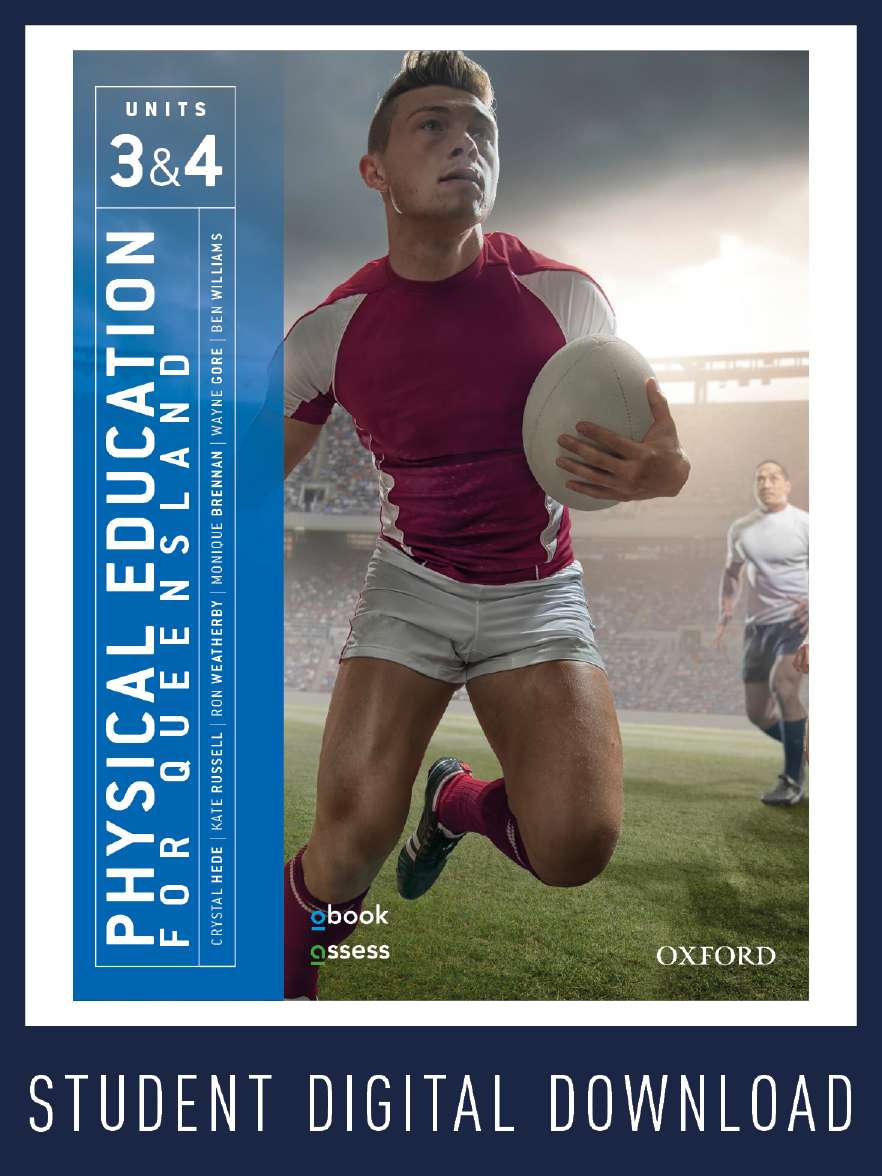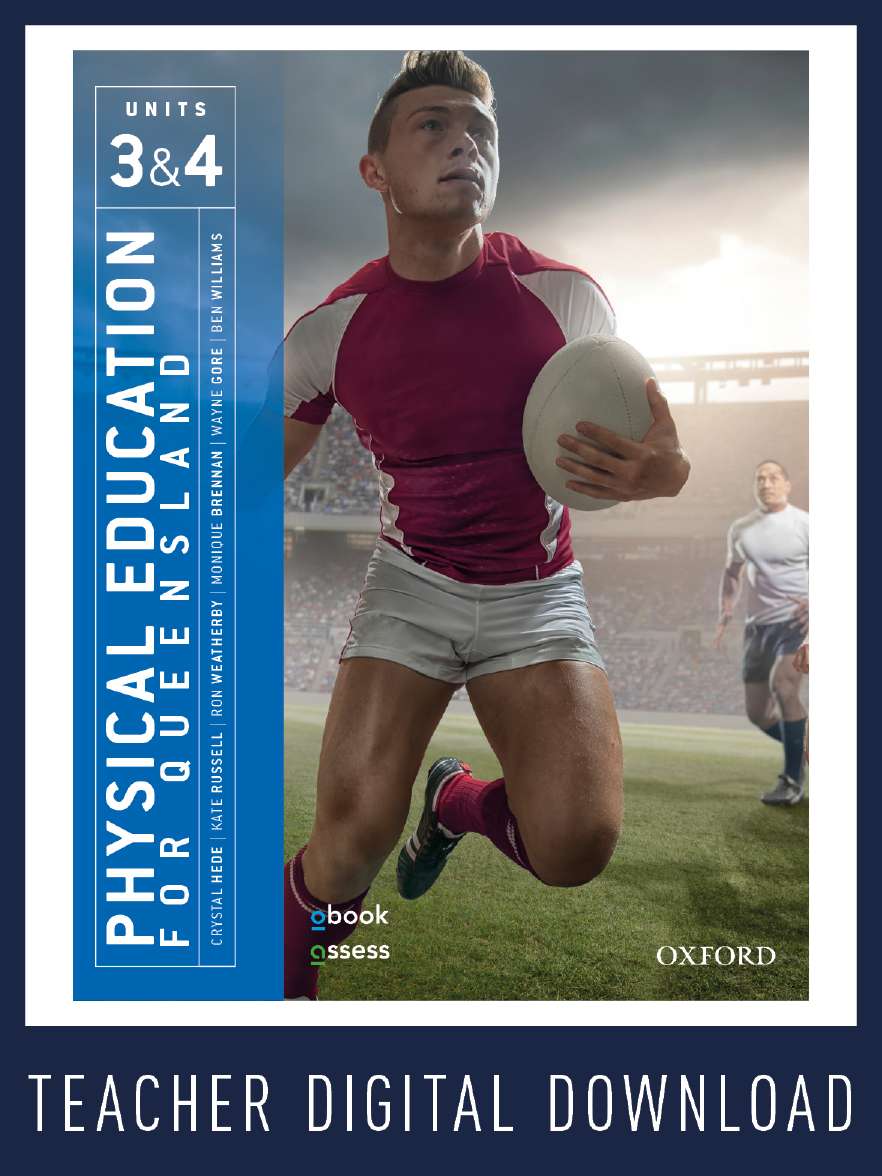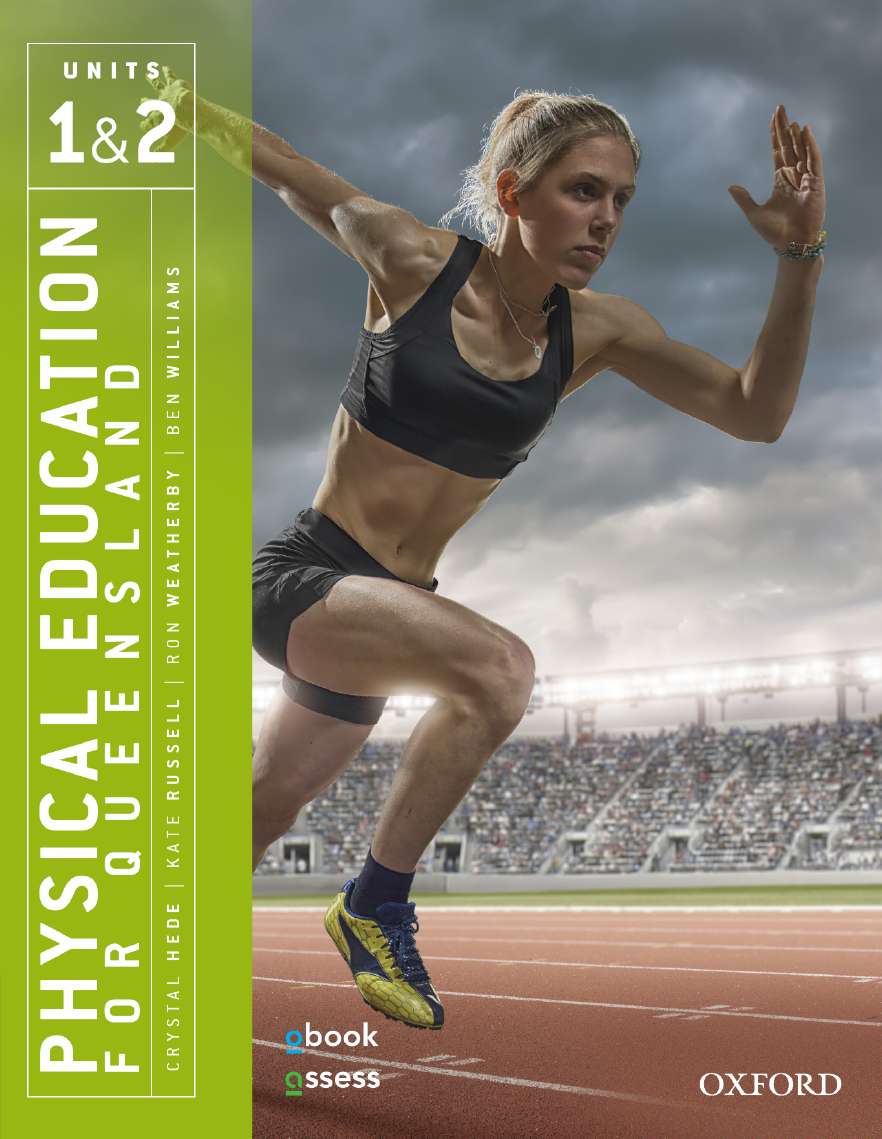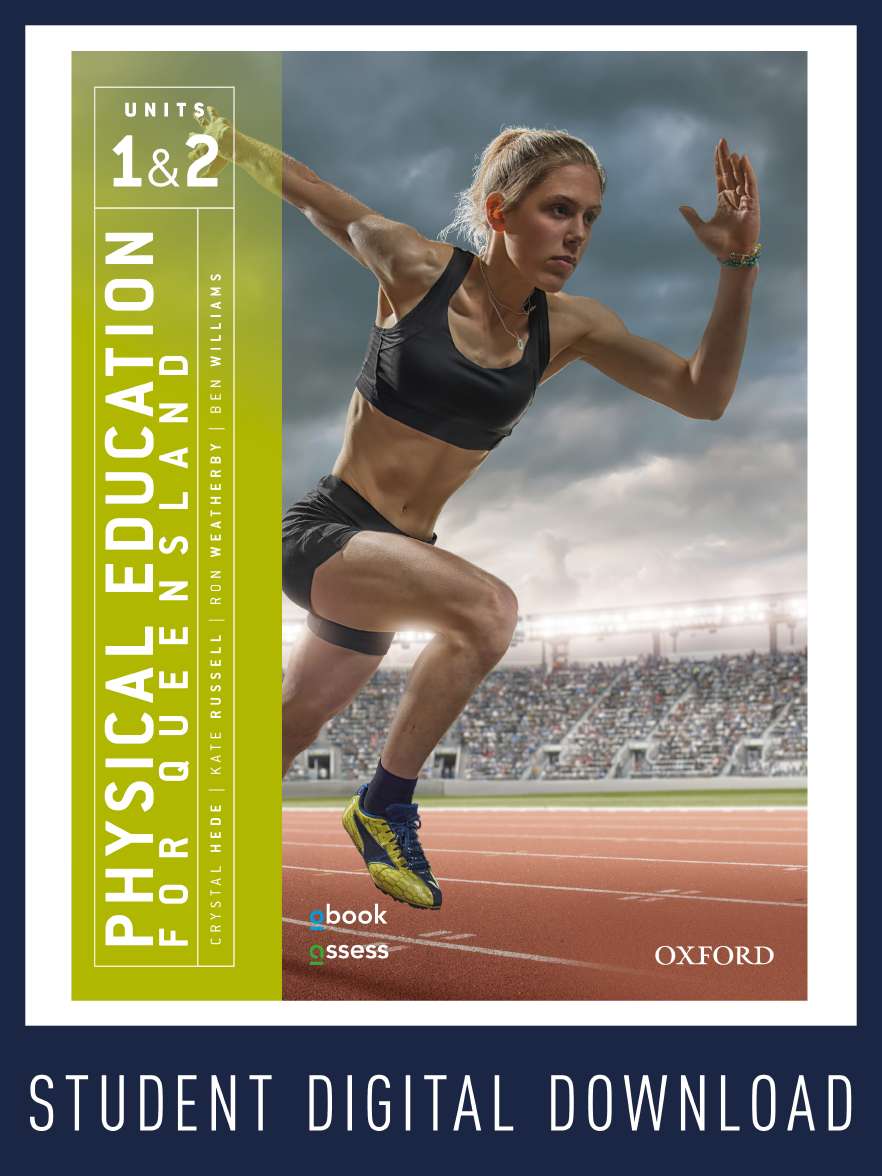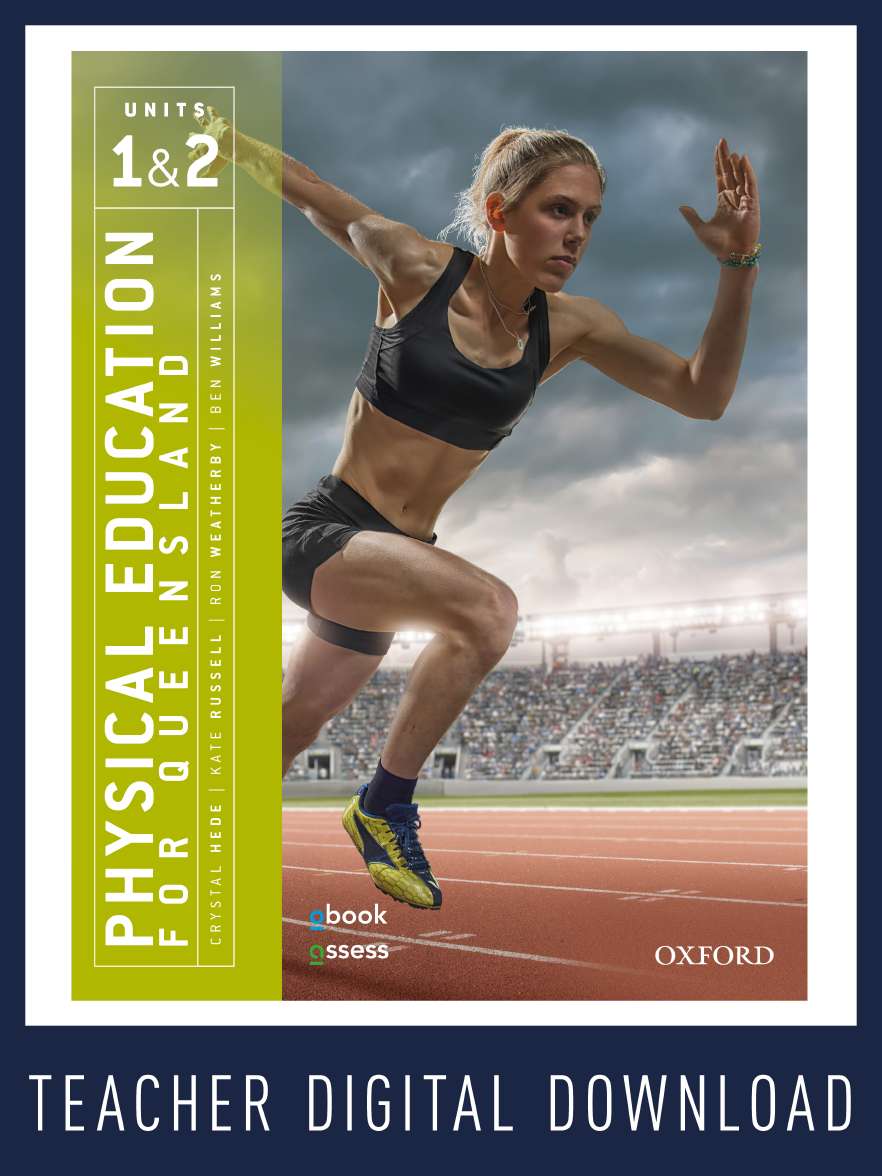Physical Education for Queensland Units 3&4 Student book + obook assess
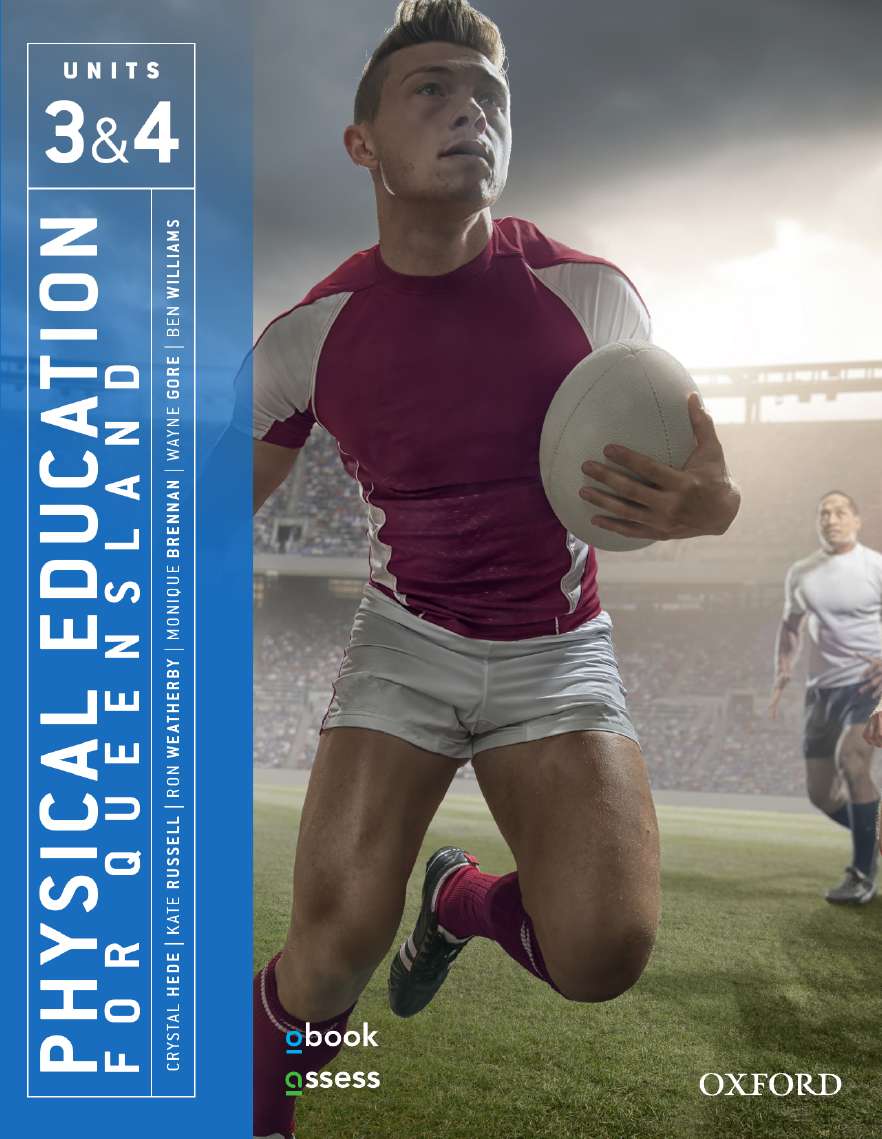
Physical Education for Queensland Units 3&4 Student book + obook assess
|
ISBN: |
9780190313241 |
|
Binding: |
Paperback + obook |
|
Published: |
4 Feb 2020 |
|
Availability: |
375
|
|
Series: |
$64.95 AUD
$73.99 NZD
Add To CartDescription
The new Queensland Senior Physical Education syllabus affects all aspects of teaching and learning, featuring new teaching content, new course structure and a new approach to assessment.
As EPAA Secondary Publisher of the Year 2017, 2018 and 2019, Oxford University Press is committed to helping teachers and students in Queensland reach their full potential.
Physical Education for Queensland provides in-depth and complete coverage of the new syllabus in a format that offers complete support for teachers and their students. This comprehensively updated edition now has two-volumes covering Units 1 & 2 (Book 1), and Units 3 & 4 (Book 2).
Key features include:
- The Physical Education toolkit: a stand-alone reference section that explains the structure of the syllabus, supports the acquisition of key skills and provides practical tips for success in Physical Education
- Learning pathways mapped clearly and directly to the syllabus to ensure complete coverage
- Engaging content, including media articles, case studies and practicals, brings the syllabus to life
- Assessment support and resources, including exam preparation and practice
- Key subject matter coverage presented using clear, concise language, supported by engaging visual elements and sequenced to scaffold student learning
- Differentiated teaching supported by a range of appropriately levelled questions and activities included for each section
- Inquiry learning and critical thinking approaches clearly modelled throughout
- Additional digital learning resources included to support both teachers and students.
Contents
Chapter 1: Physical Education toolkit
1.1 Course overview for QCE Physical Education
1.2 Assessment overview for QCE Physical Education Units 3 & 4
1.2A Tips for success on the Project – folio
1.2B Tips for success on the Investigation – report
1.2C Tips for success on the Examination – combination response
1.2D Understanding cognitive verbs
1.3 The importance of data in QCE Physical Education
1.3A Putting data to use in Physical Education
1.4 Careers in physical education, sport and fitness
UNIT 3: TACTICAL AWARENESS, ETHICS AND INTEGRITY AND PHYSICAL ACTIVITY
Chapter 2: Tactical awareness
2.1 Introduction to tactical awareness
2.2 Approaches to motor learning and the development of tactical awareness
2.3 The dynamic systems approach and dynamic models of learning
2.4 Introduction to a constraints-led approach to teaching and learning
2.5 Implementing a constraints-led approach
2.6 Assessment support – Summative internal assessment 1: Project – folio
2.7 Developing tactical awareness in ‘invasion’ physical activities [ONLINE ONLY]
2.7A Australian football
2.7B Basketball
2.7C Futsal
2.7D Netball
2.7E Soccer
2.7F Touch football
2.7G Water polo
2.8 Developing tactical awareness in ‘net and court’ physical activities [ONLINE ONLY]
2.8A Badminton
2.8B Tennis
2.8C Volleyball
Chapter 2 review
Chapter 3: Ethics and integrity
3.1 Introduction to ethics and integrity
3.2 Ethics and integrity in sport and physical activity
3.3 Fair play
3.4 Developing personal values and ethical behaviours
3.5 The influence of ethical values and ethical strategies on fair play and integrity
3.6 The influence of globalisation and mass media coverage on ethical values and behaviours
3.7 Ethical dilemmas
3.8 The ethical decision-making framework
3.9 Assessment support for summative internal assessment 2
Chapter 3 review
UNIT 4: ENERGY, FITNESS AND TRAINING AND PHYSICAL ACTIVITY
Chapter 4: Energy, fitness and training
4.1 Introduction to energy, fitness and training
4.2 Energy requirements for physical activity
4.3 Energy systems used in physical activity
4.4 Fitness requirements for physical activity
4.5 The role of oxygen in performance
4.6 Training requirements for physical activity
4.7 Training zones
4.8 Principles of training
4.9 Training methods
4.9A Continuous training
4.9B Fartlek training
4.9C Resistance training
4.9D Interval training
4.9E Flexibility training
4.9F Circuit training
4.10 Fatigue and recovery in training
4.11 The theory of periodisation
4.12 Developing a training program
4.13 Developing a training session plan
4.14 Assessment support – Summative internal assessment 3: Project – folio
Chapter 4 review
Chapter 5: Unit 4 revision and examination preparation
5.1 Energy requirements for physical activity including energy systems
5.2 Fitness requirements for physical activity
5.3 The role of oxygen in performance and training zones
5.4 Principles of training
5.5 Training methods, fatigue and recovery in training
5.6 The theory of periodisation
5.7 Developing training programs and training sessions
Chapter 6: Skill drills
1.2A Planning, creating and presenting a Project – folio [ONLINE ONLY]
1.2B Creating and presenting an Investigation – report [ONLINE ONLY]
1.3A Strategies for improving your results on the Examination – combination response [ONLINE ONLY]
1.3B Conducting a survey and presenting the results [ONLINE ONLY]
1.3C Using the internet to find relevant, credible and reliable sources [ONLINE ONLY]
2.3 Devising a personal tactical strategy
2.4 Evaluate the effectiveness of decision making in authentic game settings
2.6 Evaluate the effectiveness of your personal tactical strategy
3.4 Implement your values in physical activities
3.7 Ethical dilemmas exercise
3.8 Apply the decision-making framework to an ethical dilemma
4.5 Determine your fitness profile
4.5A Use heart rate recovery as a measure of fitness
4.5B Determine your VO2 max
4.5C Determine your lactate threshold
5.1 Evaluate the effectiveness of a training session on a particular energy system
5.2 Determine personal performance capacities for a physical activity using customised fitness testing
5.3 Using heart rate to determine if you are in the correct training zone
5.4 Determine the importance of applying the training principles when developing a training program
5.5 Determine the impact of volume, intensity and skill work for development of a specialised movement sequence
5.6 Determine the importance of periodisation
5.7 Evaluating the importance of a correctly structured warm up
Glossary
Index
Authors
Crystal Hede
Crystal Hede has been the Head of Health and Physical Education at The Glennie School for over 10 years. She has lead curriculum change and held the position of IT mentor, supporting the broader staff body in the implementation of technology to enhance teaching and learning. She has also been a district panellist for senior Physical Education.
Kate Russell
Kate Russell has taught Health and Physical Education in Queensland for 14 years, including as Head of Department at St Saviour’s College. As a district review panellist, Kate has contributed to the development of the Physical Education syllabus over many years. Kate now specialises in the field of child behaviour, psychology and development, working to help parents and educators build positive relationships with the children in their care.
Ron Weatherby
Ron Weatherby has been a Health and Physical Education teacher for over 30 years and has been Head of Department at Lockyer District State High since 1997. Ron has been involved with senior Physical Education curriculum development at all levels since 1995, acting as a panellist, district review panel chair and state member over this time. Ron was also a member of the review panel for the new senior Physical Education syllabus and is currently presenting at workshops and developing resources for its implementation in 2019.
Monique Brennan
Monique Brennan is an experienced Health and Physical Education teacher and Head of Department who has taught across a range state and Catholic schools. Monique led the implementation of the Australian Curriculum: HPE for Brisbane Catholic Education, providing guidance and support for teachers. Monique is passionate about the lifelong positive effects of quality health and physical education and currently leads Middle Years Curriculum at Carmel College in Brisbane.
Wayne Gore
Wayne Gore is the Head of Physical Education at Anglican Church Grammar School (Churchie) in Brisbane. He is a committed educator with over 20 years’ teaching experience. Wayne is a management committee member with ACHPER Australia Queensland Branch and has also worked as a Panel Member, QCAA Endorsement Assessor (trial).
Ben Williams
Ben Williams is a Lecturer in Health and Physical Education in the School of Education and Professional Studies at Griffith University. He is a member of the QCAA's state review panel and has been a member of many health and physical education industry advisory panels. He is also President of the Australian Council for Health, Physical Education and Recreation's Queensland Branch (ACHPER QLD). Before completing his PhD and joining Griffith University, Ben was a Health and Physical Education teacher at The Gap State High School.
Student Resources
This resource includes a physical copy of the Student book and access to obook assess which is a cloud-based obook that students can use anywhere, anytime, on any device.
obook assess provides Students with access to:
- a complete digital version of the Student book with added note-taking and bookmarking functionality
- free Oxford Concise Dictionary look-up feature
- targeted instructional videos by some of Queensland’s most experienced Physical Education teachers, designed to help students prepare for assessment tasks and exams
- a range of engaging worksheets for every chapter, designed to consolidate and extend understanding of key content from the syllabus
- additional case studies and opportunities for extension
- a range of interactive, auto-correcting, multiple-choice assess quiz questions.
Teacher Resources
This resource is supported by the Physical Education for Queensland Units 3 & 4 2E Teacher obook assess (ISBN: 9780190313289).
Teacher obook assess is available FREE to booklisting schools or schools that purchase a class set of 25 or more copies. Contact your Oxford Education Consultant via www.oup.com.au/contact to discuss your requirements and request a demonstration.
obook assess is a cloud-based obook that teachers and students can use anywhere, anytime on any device.
obook assess provides teachers with access to:
- detailed course planners, teaching programs and lesson plans
- answers to all questions and assessment tasks in the Student book
- chapter summary PowerPoint presentations and revision notes ideal for individual or whole-class revision
- printable (and editable) assessment tasks and tests with answers
- printable (and editable) practice exam with answers
- all student resources listed below.
With obook assess, teachers can:
- set in-platform assessment tasks with the ability to create groups and tailor instructions to meet the different needs of abilities of different students
- monitor student progress and graph results
- view all available content and resources in one place.
Teachers will have access to the following student resources via obook assess:
- a complete digital version of the Student book with added note-taking and bookmarking functionality
- free Oxford Concise Dictionary look-up feature
- targeted instructional videos by some of Queensland’s most experienced Physical Education teachers, designed to help students prepare for assessment tasks and exams
- a range of engaging worksheets for every chapter, designed to consolidate and extend understanding of key content from the syllabus
- additional case studies and opportunities for extension
- a range of interactive, auto-correcting, multiple-choice assess quiz questions.
